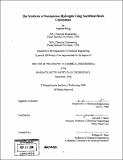| dc.contributor.advisor | Kenneth J. Beers. | en_US |
| dc.contributor.author | Kang, Jungmee | en_US |
| dc.contributor.other | Massachusetts Institute of Technology. Dept. of Chemical Engineering. | en_US |
| dc.date.accessioned | 2007-04-20T15:53:46Z | |
| dc.date.available | 2007-04-20T15:53:46Z | |
| dc.date.copyright | 2006 | en_US |
| dc.date.issued | 2006 | en_US |
| dc.identifier.uri | http://hdl.handle.net/1721.1/37224 | |
| dc.description | Thesis (Ph. D.)--Massachusetts Institute of Technology, Dept. of Chemical Engineering, 2006. | en_US |
| dc.description | Includes bibliographical references (leaves 102-106). | en_US |
| dc.description.abstract | The purpose of this research is to synthesize nanostructured and porous hydrophilic networks (nanoporous hydrogels) using block copolymers and to understand their transport properties. Nanoporous materials are synthesized by connecting two or more chemically distinct polymer blocks, inducing microphase separation to form a pattern on the scale of tens of nanometers, and finally removing one of the polymer blocks. The sacrificial block needs to be degraded easily and controllably and the blocks must self-assemble. Desired properties for the non-degradable polymer block are that it be hydrophilic and that it can be crosslinked to form a hydrogel. Advantages of the nanoporous hydrogels are hydrophilicity and flexibility, and the hydrophilic nature would make these membranes suitable for the separation, based on size selectivity, of biological macromolecules such as proteins. Hydrogels with nanoscale structure were synthesized using amphiphilicpoly(c-caprolactone-b-ethylene oxide-b-s-caprolactone) (PCL-b-PEO-b-PCL) triblock copolymers. The triblock copolymer was produced by the ring opening polymerization of c-caprolactone with PEO as a macro-initiator in the presence of stannous octoate as a catalyst. | en_US |
| dc.description.abstract | (cont.) PCL and PEO have a sufficiently high segment-segment interaction parameter to induce microphase separation in bulk (the calculated XFH is 0.15 at 70 °C) or in water. PCL degrades easily in a NaOH aqueous solution. PEO is hydrophilic and crosslinkable by ultraviolet (UV) or other forms of ionizing radiation such as an electron beam or 60Co. A pore size is controlled by the molecular weights of the block copolymers. Furthermore, terminal hydroxyl groups of PEO are restored after PCL removal that allow further chemical modification. To search for optimum crosslinking conditions, PEO homopolymers were studied. Electron beam irradiation of up to 50 Mrads on PEO bulk films did not produce networks when the primary molecular weights of PEO were small. Gel fractions of electron beam crosslinked polymers increased when the primary molecular weight of PEO increased, but the produced Mc (molecular weight between crosslinks) values were too high to achieve fine mesh sizes. Therefore, aqueous solutions of PEO were studied to achieve lower M. values (-1,500 g/mol). Microstructures in aqueous solutions of PCL-PEO-PCL block copolymers were studied by Small Angle X-ray Scattering (SAXS). | en_US |
| dc.description.abstract | (cont.) The SAXS studies show that the block copolymers form 30-40 nm structures in aqueous solution. Lamellar and cylindrical nanostructures were observed by SAXS, indicating cylindrical structure as the block lengths become more different in length. The lamellar structure remained after electron-beam crosslinking of the block copolymers as shown by Atomic Force Microscopy (AFM). It is demonstrated through Fourier Transform Infrared Spectroscopy (FTIR), mass loss, and Differential Scanning Calorimetry (DSC) that the PCL can be completely removed by hydrolysis in NaOH(aq) to form porous PEO hydrogels. After PCL removal, the resulting nanoporous hydrogels have relatively high macromolecular diffusivities due to pores produced by PCL removal as observed in Fluorescence Recovery After Photobleaching (FRAP) studies. The effect of temperature and water content on morphology of PCL-b-PEO-b-PCL, with block number average molecular weights of 9,000-30,000-9,000 g/mol, was also studied. Cylindrical morphology was observed in a solvent-evaporated sample. When it was heated above the melting peaks of both PEO and PCL blocks, a change in morphology was observed by SAXS. | en_US |
| dc.description.abstract | (cont.) When this sample was cooled to room temperature in the ambient atmosphere, another morphology (lamellae) was observed with SAXS and AFM. This asymmetric change in morphology across the melting-crystallization transition suggests a role of kinetics (microphase separation and crystallization) in determining the observed microstructures. Addition of water at room temperature also affected the microphase separation of the block copolymer due to hydrophilicity of PEO. As the polymer concentration is decreased below 60%, the morphology changes from cylinders to lamellae. DSC shows that water addition decreases PEO crystallinity but PCL crystallinity remains. These hydrogels retain active functional groups following PCL removal that serve as sites for further chemical modification with pH or temperature responsive materials, which may find use in drug separation and drug delivery systems. | en_US |
| dc.description.statementofresponsibility | by Jungmee Kang. | en_US |
| dc.format.extent | 106 leaves | en_US |
| dc.language.iso | eng | en_US |
| dc.publisher | Massachusetts Institute of Technology | en_US |
| dc.rights | M.I.T. theses are protected by copyright. They may be viewed from this source for any purpose, but reproduction or distribution in any format is prohibited without written permission. See provided URL for inquiries about permission. | en_US |
| dc.rights.uri | http://dspace.mit.edu/handle/1721.1/7582 | |
| dc.subject | Chemical Engineering. | en_US |
| dc.title | The synthesis of nanoporous hydrogels using sacrificial block copolymers | en_US |
| dc.type | Thesis | en_US |
| dc.description.degree | Ph.D. | en_US |
| dc.contributor.department | Massachusetts Institute of Technology. Department of Chemical Engineering | |
| dc.identifier.oclc | 85812770 | en_US |
